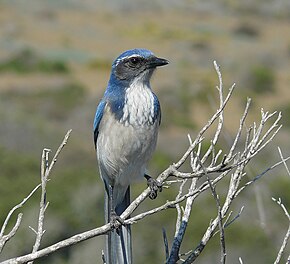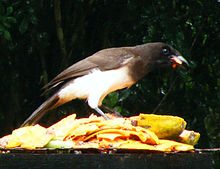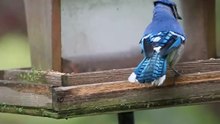New World Jay

The Neuwelthäher (deprecated Blue Jays ) are a group of birds within the family of corvids (Corvidae). They include all genera of families that are unique to America . They show several similarities that distinguish them from the rest of the family, for example in the plumage or the anatomy of the temporomandibular joint.
The New World jays were the first corvids to reach the American continent and to establish themselves there. Although they are monophyletic , i.e. all descend from a common ancestor, the New World Jays are not a taxon in the true sense of the word .
features
The New World Jays are small to medium-sized corvids. With the little jay ( Cyanolyca nana ) weighing only about 40 g , they comprise the smallest member of the Corvidae family. Almost all species have ten arm wings , the only exception being the naked jay ( Gymnorhinus cyanocephalus ) with eleven.
All New World jays have a characteristic jaw morphology, which is an adaptation to the chopping of nuts and seeds: The lower jaw joint supports the lower jaw through an indentation at the end of the jawbone. This enables the New World cutters to use their lower jaw as a chisel or skewer even when the beak is open and at the same time remove the shell of the seeds with their upper beak. This allows acorns or peanuts to be opened very quickly and effectively. This feature is relatively weak in the more original jackdaws ( Cyanolyca ), but it is very pronounced in the younger blue ravens ( Cyanocorax ) and North American New World jays.
Systematics and history of development
|
|||||||||||||||||||||||||||
| Internal systematics of the recent new world jars according to Bonaccorso & Peterson 2007 |
The New World Jays are monophyletic , so they descend from a common ancestor. This ancestor of today's species probably resembled the East Asian blue magpie ( Cyanopica cyana ) and immigrated to North America in the late Miocene 8-10 million years ago. In the warm climate at that time, there was a land bridge with extensive deciduous forests between Eurasia and North America, which favored the spread of the New World Meading ancestor. In the Pliocene 5.3–3.6 million years ago, several species advanced independently of one another across the emerging isthmus from Panama to South America.

The new world jay includes 34 recent and three extinct species, which are spread over a total of nine genera. In addition to these genera, two more are sometimes recognized, the monotypical brown jay ( Psilorhinus ) and Calocitta with two species. However, both genera are systematically within the blue ravens ( Cyanocorax ), which means that this genus must either be divided or, in order to preserve its monophyly, must also include Calocitta and Psilorhinus . DNA studies also indicate that the blue ravens contain some previously unrecognized crypto species , which could further increase the number of known New World Jay species.
The most original living New World jays belong to the genus Cyanolyca . They represent an early radiation in Central America and later colonized South America as well. The blue ravens also developed in Central America. A younger group are the naked- billed jays ( Gymnorhinus ) and the bush jays ( Aphelocoma ) and blue jays ( Cyanocitta ), which are mainly found in North America.
The fossil genera Henocitta and Protocitta from the late Pleistocene of North America are probably closely related to the blue ravens . Miocitta from the late Miocene of Colorado , on the other hand, is the oldest known form of the New World jay.
swell
literature
- Elisa Bonaccorso, A. Townsend Peterson: A Multilocus Phylogeny of New World Jay Genera. In: Molecular Phylogenetics and Evolution 42, 2007. doi : 10.1016 / j.ympev.2006.06.025 , pp. 467-476.
- Elisa Bonaccorso, A. Townsend Peterson, Adolfo G. Navarro-Sigüenza, Robert C. Fleischer : Molecular Systematics and Evolution of the Cyanocorax Jays. In: Molecular Phylogenetics and Evolution 54, 2010. doi : 10.1016 / j.ympev.2009.11.014 , pp. 897-909.
- Pierce Brodkorb: Neogene Fossil Jays from the Great Plains. In: The Condor 74 (3), 1972). Pp. 347-349.
- Derek Goodwin : Crows of the World. 2nd Edition. The British Museum (Natural History) , London 1986, ISBN 0565009796 .
- Joseph del Hoyo, Andrew Elliot, David Christie (Eds.): Handbook of the Birds of the World. Volume 14: Bush-shrikes To Old World Sparrows. Lynx Edicions, Barcelona 2009. ISBN 9788496553507 .
- Steve Madge, Hilary Burn: Crows & Jays. Princeton University Press, Princeton 1994. ISBN 0-691-08883-7 .
- Richard L. Zusi: A Feeding Adaption of the Jaw Articulation in the New World Jays (Corvidae). In: The Auk 104, 1987. pp. 665-680.
Individual evidence
- ↑ del Hoyo et al. 2009 , pp. 510-514.
- ↑ Zusi 1987 , pp. 671-672.
- ↑ Zusi 1987 , p. 677.
- ↑ del Hoyo et al. 2009 , p. 505.
- ↑ Bonaccorso et al. 2010 , p. 904.
- ↑ Bonaccorso & Peterson 2007 , p. 474.
- ↑ del Hoyo et al. 2009 , pp. 498-502.
- ↑ Brodkorb 1972 , p. 904.
